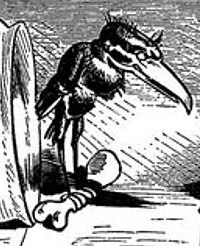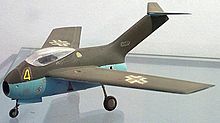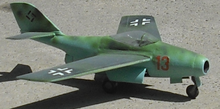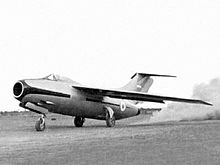Focke-Wulf Ta 183
This article needs additional citations for verification. (September 2010) |
| Ta 183 Huckebein | |
|---|---|

| |
| Wind tunnel model | |
| Role | Fighter/Interceptor |
| Manufacturer | Focke-Wulf |
| Status | Terminated by the end of the war |
| Primary user | Luftwaffe |
| Number built | None completed |
| Developed into | Focke-Wulf Volksjäger, Focke-Wulf Super Lorin FMA IAe 33 Pulqui II |
The Focke-Wulf Ta 183 Huckebein was a design for a jet-powered fighter aircraft intended as the successor to the Messerschmitt Me 262 and other day fighters in Luftwaffe service during World War II. It had been developed only to the extent of wind tunnel models when the war ended, but the basic design was further developed postwar in Argentina as the FMA IAe 33 Pulqui II. The name Huckebein is a reference to a trouble-making raven (Hans Huckebein der Unglücksrabe) from an illustrated story in 1867 by Wilhelm Busch.[1]
Development
In early 1944, the

The result was a series of advanced designs, some using
Design




Development of the Ta 183 started as early as 1942 as Project VI, when the engineer
The wings were swept back at 40° and were mounted in the mid-
The original design used a
The Ta 183 had a short fuselage with the air intake passing under the cockpit and proceeding to the rear where the single engine was located. The pilot sat in a pressurized cockpit with a bubble canopy which provided excellent vision. The primary armament of the aircraft consisted of four 30 mm (1.18 in) MK 108 cannons arranged around the air intake.
It was also possible to carry a bomb load of 500 kg (1,100 lb), consisting of one SD or more SC 500 half-tonne bombs, one Bombentorpedo BT 200 bomb, five SD-series fragmentation bombs, SC-series general-purpose bombs, or a Rb 20/30 reconnaissance camera. The weapons load would be carried in the equipment space in the bottom of the fuselage and thus partially protrude about halfway from the fuselage, possibly allowing for other armament packages such as the Ruhrstahl X-4 wire-guided missile.
Multhopp's team also seriously explored a second version of the basic design, known as Design III, a modified Design II (it is unknown what Design I referred to). The first of these had only minor modifications, with slightly differently shaped wingtips and repositioning of the undercarriage. The second version had a reduced sweepback to 32°, allowing the wing and cockpit to be moved rearward. The tail was also redesigned, using a short horizontal boom to mount the control surfaces just above the line of the rear fuselage. This version looks considerably more "conventional" to the modern eye, although somewhat stubby due to the short overall length of the HeS 011.
The second of these two schemes was entered in the official competition ordered by the Oberkommando der Luftwaffe at the end of 1944. On 28 February 1945, the Luftwaffe High Command examined the various Emergency Fighter proposals and selected the Junkers EF 128 to be developed and produced; the Focke-Wulf team gained second place. However, in the last few weeks of the war, it was decided that the Huckebein was really the best design and, at a meeting in Bad Eilsen, Tank was told to arrange mockups and to plan for full production. It had a planned speed of about 1,000 km/h (620 mph) at 7,000 m (22,970 ft) and it was estimated that 300 aircraft per month would be delivered when production got into its stride, each aircraft being produced in 2,500 man hours.
A total of 16 prototypes were to be built, allowing the tail unit to be interchanged between the Design II and III variations. Of the Versuchs (experimental test series) aircraft, the Ta 183 V1-V3 were to be powered by the Jumo 004B turbojet with somewhat lengthened rear fuselages near the engine's exhaust nozzle to accommodate them, pending delivery of the HeS 011 jet engine. The Ta 183 V4-V14 were intended to be A-0 series pre-production aircraft and V15-V16 were to be static test aircraft. The first flight of the aircraft was projected for May 1945, but no finished Ta 183 Versuchs-series prototypes had been completed by 8 April 1945, when British troops captured the Focke-Wulf facilities.
Influence

After the end of the war,

Historians including David Myrha[6] have claimed the Soviet Mikoyan-Gurevich MiG-15 was at least inspired by the Ta 183, because the Soviets captured plans from the Germans at the end of World War II. The MiG-15 does bear a resemblance in layout, sharing the high tailplane and nose-mounted intake, although the aircraft are different in structure, details, and proportions. The MiG-15's design shared features, and some appearance commonalities with the MiG design bureau's own 1945-46 attempt at a Soviet-built rocket interceptor similar to the Messerschmitt Me 263 rocket fighter, and also common to many contemporary jet fighters — and were derived from aerodynamic and structural considerations (for example, the American Republic F-84F, the Swedish SAAB 29, and the French Dassault Ouragan and Mystère). A detailed design history of the MiG-15 was published by Russian aviation historian Yefim Gordon[7] refuting any connection between the Ta 183 and the MiG-15. According to the designers, the MiG-15 was an indigenous design, their choice of swept wings (as swept-back wings of any sort on a Soviet-designed aircraft were first flown on the MiG-8 Utka canard light aircraft of 1945) being due to their desire to move ahead of most Western designs which were not intended for the 960 km/h+ (600 mph+) speed range.
Like the MiG-9 and MiG-15, the Saab 29 is subject to claims of having been indirectly influenced by the Ta 183. SAAB engineers received German research studies in swept wings in the immediate post-war period via contacts in Switzerland, and incorporated it into the Tunnan design, which was still limited to paper studies at the time.[8]
Specifications (Ta 183, as originally designed)

Data from Jet Planes of the Third Reich[9]
General characteristics
- Crew: 1
- Length: 9.4 m (30 ft 10 in)
- Wingspan: 10 m (32 ft 10 in)
- Height: 3.86 m (12 ft 8 in)
- Wing area: 22.5 m2 (242 sq ft)
- Empty weight: 2,830 kg (6,239 lb)
- Gross weight: 4,300 kg (9,480 lb)
- Powerplant: 1 × Heinkel HeS 011 turbojet, 13 kN (2,900 lbf) thrust
Performance
- Maximum speed: 955 km/h (593 mph, 516 kn)
- Service ceiling: 14,000 m (46,000 ft)
- Rate of climb: 20.4 m/s (4,020 ft/min)
- Wing loading: 196 kg/m2 (40 lb/sq ft)
- Thrust/weight: 0.37
Armament
- Guns: 4 × 30 mm (1.18 in) MK 108 cannon
- Hardpoints: 4
- Missiles: 4 × Ruhrstahl X-4 Wire Guided AAMs
- Bombs: 500 kg (1,102 lb) of bombs
See also
Related development
- Focke-Wulf Flitzer
- Focke-Wulf Super Lorin
- Focke-Wulf Volksjäger
- Focke-Wulf Ta 283
- FMA IAe 33 Pulqui II
Aircraft of comparable role, configuration, and era
- Lavochkin La-15
- Mikoyan-Gurevich MiG-15
- Messerschmitt Me P.1101
- Saab 29 Tunnan
References
Notes
- ^ "Hans Huckebein." Spiegel online. Retrieved: 5 April 2015.
- ^ de Bie, Rob. "Me 163B Komet - Me 163 Production - Me 163B: Werknummern list." robdebie.home. Retrieved: 28 July 2013.
- ^ "Me 163." walterwerke.co.uk. Retrieved: 28 August 2010.
- ^ Myhra 1999, p. 7.
- ^ Myrha 1999, pp. 7–10.
- ^ Myrha 1999, pp. 10, 11.
- ^ Gordon 2001, pp. 3–6.
- ^ Erichs et al. 1988, p. 37.
- ISBN 0-914144-27-8.
Bibliography
- Ciampaglia, Giuseppe. Il Focke Wulf Ta-183. Il capostipite dei caccia a getto di seconda generazione. Rivista Italiana Difesa, gennaio, 2013.
- Erichs, Rolph et al. The Saab-Scania Story. Stockholm: Streiffert & Co., 1988. ISBN 91-7886-014-8.
- Gordon, Yefim. Mikoyan-Gurevich MiG-15: The Soviet Union's Long-Lived Korean War Fighter. Earl Shilton, Leicester, UK: Midland Publishing Ltd., 2001. ISBN 1-85780-105-9.
- Myhra, David. Focke-Wulf Ta 183 (X Planes of the Third Reich). Atglen, Pennsylvania: Schiffer Publishing, 1999. ISBN 0-7643-0907-2.
